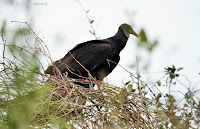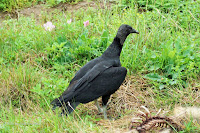BLACK VULTURE
BLACK VULTURE (Coragyps atratus) – (See images below)
DESCRIPTION: The Black vulture is a New World bird of prey. It is entirely black, including the bare head, where the skin is wrinkled. The bill is black, and yellow at the tip. The nostrils are pervious, i.e. wide open to allow a better sense of smell. The legs are light grey. Sexes are similar. Its size is fairly large, at approximately 70 cm (28 inches) long.
VOICE: https://www.xeno-canto.org/species/Coragyps-atratus – Black vultures lack a voice box, so can only emit a limited range of sounds.
NAME: The black vulture is also called American Black Vulture to distinguish it from another bird also named Black Vulture, a raptor from the Old World. The name ‘Vulture’ means ‘to tear’ in Latin, in reference to the way this bird feeds itself. The Latin genus name ‘Coragyps’ means ‘raven-vulture’. The Latin species name ‘atratus’ refers to the bird’s black plumage.
HABITAT: Open spaces near roads (for road kill) and garbage dumps.
DIET: Mainly carrion, also garbage and injured animals.
NESTING: This bird will build its nest in trees or other available cavities not far from its feeding areas. Two light blue eggs are laid, incubated by both parents. Chicks are fed by both parents.
DISTRIBUTION: The distribution area starts from the southeastern USA and extends southward to almost the whole South America. Black vultures do not migrate.
DISTRIBUTION MAP: https://en.wikipedia.org/wiki/Black_vulture#/media/File:AmericanBlackVultureMap.png
ON PEI: The black vulture is not breeding on Prince Edward Island but its normal range keeps expanding northward. Sightings of this bird on the island so far have only been accidental or occasional.
CONSERVATION: This bird went through various cycles in terms of numbers, in part due to humans’ attitude toward them. For example, they were tolerated in the 1800s around markets for cleaning up discarded carcasses. Then in the early 1900s they were deemed a source of disease spread (unproven) and killed in the thousands. Then later they were impacted by DDT, and also poisoned by the lead in some of the carcasses they feed on. Recently though, their population has increased.
NOTES: Vultures don’t have the capacity to grasp prey due to weak talons. In order to digest the carcasses they feed from, they have strong stomach acids and gut bacteria that would kill a human. Black vultures will defecate on their own legs to keep them cool.
Black vultures are fairly social and maintain strong family ties. In addition to gathering with other birds of its own species, they will also associate with Turkey Vultures. They have a poor sense of smell as opposed to turkey vultures, so will follow the latter to locate carrion.
SIMILAR SPECIES: Turkey Vulture
REFERENCES: https://en.wikipedia.org/wiki/Black_vulture
https://www.allaboutbirds.org/guide/Black_Vulture/id
https://www.peregrinefund.org/explore-raptors-species/Black_Vulture
https://www.audubon.org/field-guide/bird/black-vulture
https://www.thespruce.com/black-vulture-385618
https://hawkwatch.org/learn/factsheets/item/808-black-vulture
https://nature.mdc.mo.gov/discover-nature/field-guide/black-vulture (Missouri Department of Conservation)
DESCRIPTION: The Black vulture is a New World bird of prey. It is entirely black, including the bare head, where the skin is wrinkled. The bill is black, and yellow at the tip. The nostrils are pervious, i.e. wide open to allow a better sense of smell. The legs are light grey. Sexes are similar. Its size is fairly large, at approximately 70 cm (28 inches) long.
VOICE: https://www.xeno-canto.org/species/Coragyps-atratus – Black vultures lack a voice box, so can only emit a limited range of sounds.
NAME: The black vulture is also called American Black Vulture to distinguish it from another bird also named Black Vulture, a raptor from the Old World. The name ‘Vulture’ means ‘to tear’ in Latin, in reference to the way this bird feeds itself. The Latin genus name ‘Coragyps’ means ‘raven-vulture’. The Latin species name ‘atratus’ refers to the bird’s black plumage.
HABITAT: Open spaces near roads (for road kill) and garbage dumps.
DIET: Mainly carrion, also garbage and injured animals.
NESTING: This bird will build its nest in trees or other available cavities not far from its feeding areas. Two light blue eggs are laid, incubated by both parents. Chicks are fed by both parents.
DISTRIBUTION: The distribution area starts from the southeastern USA and extends southward to almost the whole South America. Black vultures do not migrate.
DISTRIBUTION MAP: https://en.wikipedia.org/wiki/Black_vulture#/media/File:AmericanBlackVultureMap.png
ON PEI: The black vulture is not breeding on Prince Edward Island but its normal range keeps expanding northward. Sightings of this bird on the island so far have only been accidental or occasional.
CONSERVATION: This bird went through various cycles in terms of numbers, in part due to humans’ attitude toward them. For example, they were tolerated in the 1800s around markets for cleaning up discarded carcasses. Then in the early 1900s they were deemed a source of disease spread (unproven) and killed in the thousands. Then later they were impacted by DDT, and also poisoned by the lead in some of the carcasses they feed on. Recently though, their population has increased.
NOTES: Vultures don’t have the capacity to grasp prey due to weak talons. In order to digest the carcasses they feed from, they have strong stomach acids and gut bacteria that would kill a human. Black vultures will defecate on their own legs to keep them cool.
Black vultures are fairly social and maintain strong family ties. In addition to gathering with other birds of its own species, they will also associate with Turkey Vultures. They have a poor sense of smell as opposed to turkey vultures, so will follow the latter to locate carrion.
SIMILAR SPECIES: Turkey Vulture
REFERENCES: https://en.wikipedia.org/wiki/Black_vulture
https://www.allaboutbirds.org/guide/Black_Vulture/id
https://www.peregrinefund.org/explore-raptors-species/Black_Vulture
https://www.audubon.org/field-guide/bird/black-vulture
https://www.thespruce.com/black-vulture-385618
https://hawkwatch.org/learn/factsheets/item/808-black-vulture
https://nature.mdc.mo.gov/discover-nature/field-guide/black-vulture (Missouri Department of Conservation)
 |
| Black vulture, female, TX, Jodi Arsenault |
 |
| Black vulture, TX, by Jodi Arsenault |